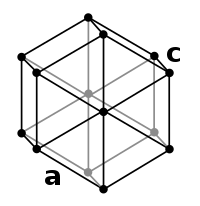
Photo from wikipedia
Carbon dioxide is the primary greenhouse gas and its emission has caused serious problems with respect to climate change. Unremitting efforts are being made to recycle of CO2 through its… Click to show full abstract
Carbon dioxide is the primary greenhouse gas and its emission has caused serious problems with respect to climate change. Unremitting efforts are being made to recycle of CO2 through its hydrogenation to liquid fuels such as CH3OH. Pd–ZnO based nanoarchitectures are one type of ideal catalysts for CO2 hydrogenation. However, owing to the lack of palladium reserves, enhancing the catalytic efficiency and selectivity of the palladium nanostructures so that low loadings can be used remains a scientific challenge. Three types of ZnO‐supported Ag@Pd core@shell, AgPd alloy, and pure Pd nanocatalysts were controllably and successfully synthesized. Benefiting from the electron‐rich Pd shell and the formation of the PdZn phase in the Ag@Pd–ZnO core@shell structure, we achieved a catalytic efficiency per gram of palladium that is 3.32 times higher than the Pd–ZnO nanostructure. In particular, electron transfer at the interfaces and the adsorption of the intermediate species significantly enhance catalytic selectivity of the Ag@Pd–ZnO core@shell structure. This work proposes a novel strategy to enhance the methanol yield during CO2 hydrogenation by the sophisticated tailoring of the surface composition in noble‐metal catalysts.
Journal Title: ChemCatChem
Year Published: 2017
Link to full text (if available)
Share on Social Media: Sign Up to like & get
recommendations!